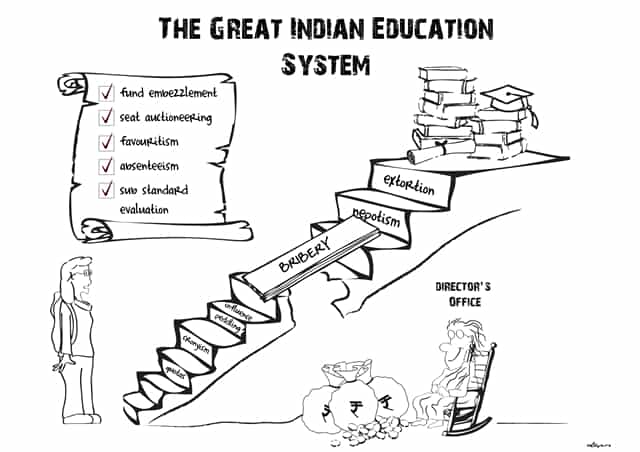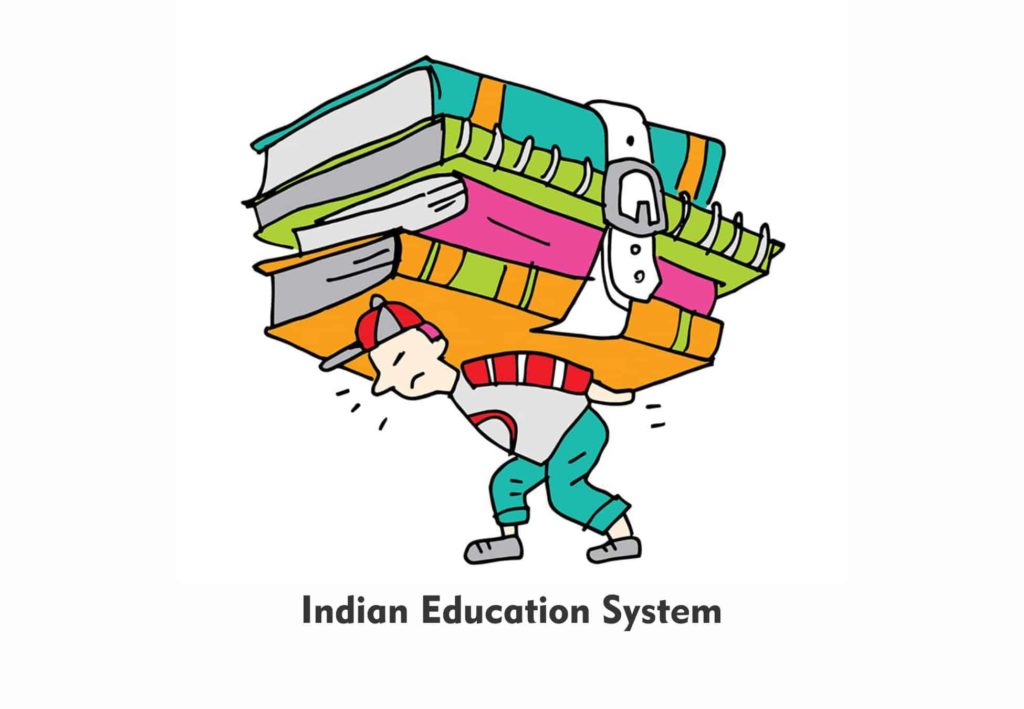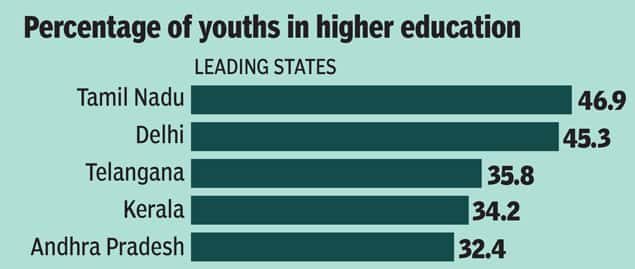In this Indian Education System Essay, we had described the education system in India, its importance & how to improve the education system in India.
With over 13, 00,000+ schools and over 315 million enrollments, India has the largest education system in the world.
Due to educational reforms since the 80s, pre-school and primary schools have been made available to all children in India.
According to the Right to Education Act 2009, schooling is free and compulsory for all children in the age group of 6 to 14 years.
Most schools in India pay attention to academics and pay less attention to extra-curricular activities; the Indian education system follows a 10 + 2 + 3 pattern.
Essay on Indian Education System 200 words:
The Indian education system is quite different from foreign nations.
In Western countries, the syllabus is considered to be quite light and based on practical knowledge, while in India the focus is on theoretical knowledge and rote scores.
Students are expected to read all the chapters and bring good grades in the classroom.
The marking system in Indian schools starts with primary classes, putting the burden on young children, the competition is increasing day by day.
Parents want their children to perform better than their peers and teachers want their class to do better than other classes.
The need to stay ahead of the competition makes them so blind that they don’t even realize that they are pushing children in the wrong direction.
At an age when students should be allowed to explore their interests and improve their creative side, they are pressured to follow a set curriculum and to get good marks.
Instead of understanding the various concepts of Mathematics, Physics and other subjects, students are given the full focus on learning the chapter.
Due to this, they are unable to take practical knowledge and are unable to make decisions for themselves further in life and cannot even choose a profession according to their interest.
Therefore, the basis of the Indian education system is very unfair.

Indian Education System Essay 300 words:
The Indian education system is said to be old and worldly.
At a time when the world is looking for creative and enthusiastic people, Indian schools are training young minds with bookish knowledge that is making them bibliophiles and preventing them from becoming a creative person.
There is no freedom to suggest or share ideas, there is a serious need for reform in the Indian education system which in turn can help to develop smarter individuals.
Need to Think Creatively:
If we want to make new inventions, then there is a need to bring positive changes in society and bring prosperity on a personal level.
However, unfortunately, our schools train us otherwise. They connect us to a defined study schedule and keep us so busy completing assignments and learning theoretical lessons that there is no room for creativity.
The Indian education system has to be changed for creative thinking.
Schools should focus on activities that challenge the student’s mind, improve their analytical skills and enhance their creative thinking ability, this will help them perform better in different areas.
All-round Development Required:
The primary focus of the Indian education system is on academics.
The focus is not on understanding the concept and increasing knowledge, but just on mug lessons to understand them with or without the sole purpose of achieving good marks.
Even though some schools have extra-curricular activities, there is hardly one class per week for these activities.
Education in Indian schools has been reduced to acquiring only theoretical knowledge which is not sufficient to raise an intelligent and responsible person.
The system should be changed to ensure the all-round development of students.
Conclusion:
Those in power must understand that the Indian education system needs serious reforms.
The system must be changed to develop students spiritually, morally, physically and mentally.
Education System in India Essay 400 words:
The Indian education system has seen quite a few changes since its beginning, it has changed with changing times and with the change in society.
However, whether these changes and developments are for good is still a question.
Gurukul:
Since ancient times, children were sent to teachers to learn lessons on various subjects and to add value to their lives and to make them efficient to lead self-reliant lives.
Gurukuls were established in different parts of the country, children used to go to Gurukul to get an education.
They used to stay in his ashram with his guru (teacher) until he completed his education.
Students were taught various skills, given lessons in various subjects and also involved in household chores to ensure their all-round development.
Changes by the British in the Indian Education System:
As the British colonized India, the Gurukul system began to erode as the British established schools that followed a separate education system.
The subjects taught in these schools were quite different from the subjects taught in Gurukuls and study sessions were conducted similarly.
There was a sudden change in the entire education system of India.
The focus shifted from students’ all-round development to academic performance, however, one thing changed for good during this period, is that girls also started taking education and enrolled in schools.
Introduction to Educomp Smart Classes:
The education system introduced by the British is still prevalent in India.
However, with the advancement in technology many schools have adopted new means to provide education to the students. Educomp Smart classrooms have been introduced in schools.
These classes have brought about a positive change unlike earlier times when students only learned from books, they now see their lessons on a large widescreen installed in their classroom rooms.
This makes the learning experience interesting and helps students understand better.
Apart from this, many extra-curricular activities are also being started by the schools for the all-round development of the students.
However, the marking system is still rigid and students have to focus largely on their academics.
Conclusion:
Therefore, there has been a major change in the Indian education system since ancient times.
However, we need further improvement in the system for proper development of students.

Indian Education System Essay 500 words:
The Indian education system is said to be largely defective. It does more harm than benefit to young minds.
However, some may argue that it gives students a good platform because it challenges their minds and focuses on the power to increase their satisfaction.
The merits and demerits of the Indian education system:
Lack of Practical Knowledge:
The focus of the Indian education system is on the theoretical part. Teachers read from the book during classes and explain the concepts orally.
Students are expected to understand complex concepts theoretically as well. The need to impart practical knowledge is not felt even when it is highly necessary.
Focus on grades:
The focus of Indian schools is on designing chapters to get good grades. Teachers do not bother if students have understood the concept or not, they all see what marks they have scored.
No importance for all-round development:
The focus is only on studies. No attempt is made to build the character of the student or his physical health. Schools do not contribute to the overall development of their students.
Over-burden of Studies:
There is a burden on students. They study for a long time in school and are given a pile of household chores to complete at home.
Also, regular classroom tests, first-term exams, weekly exams and mid-term exams put a lot of pressure on young minds.
Positive Points of Indian Education:
Some rules of the Indian education system are as follows:
Provides knowledge on Various Subjects:
The Indian education system encompasses a vast curriculum and imparts knowledge on various subjects including Mathematics, Environmental Sciences, Ethical Sciences, Social Sciences, English, Hindi and Computer Science to name a few.
All these subjects form part of the syllabus from primary classes. Therefore, students acquire knowledge about various subjects from an early age.
Enhances Discipline:
Schools in India are very particular about their timings, time tables, ethical codes, marking systems and study schedules.
Students are required to follow the rules set by the school otherwise they are punished. This is a good way to increase discipline in students.
Increases understanding of power:
Due to the marking and ranking system in Indian schools, students are required to learn their lessons well.
They need to do this to get good marks and get a higher rank than their classmates. They seek different ways to focus and for better understanding.
Those who identify tools that help them understand them better can increase their grasping power which helps them throughout their life.
Conclusion:
The Indian education system has been criticized from time to time.
There is a tremendous need to change this system to ensure the proper development of our younger generation.
Also, read 1. Globalization Essay 2. Essay on Education 3. Discipline Essay
Essay on Indian Education System in India 700 words:
Education is the criterion of social control, personality building and social and economic progress in any nation or society. India’s current education system is based on the British model, which was implemented in 1835 AD.
Pre-school Education (Play School):
Education is not compulsory at this level, but it is very popular in urban and semi-urban areas.
Childhood Montessori schools or sports schools have been opened for children up to the age of 3 years.
The preschool system has been further divided into playschools and kindergarten.
Primary School:
Primary education is compulsory for all children in India. One to fifth-grade children in the age group of 6 to 10 years is in the primary education system of India.
Pre-secondary school:
Children aged between 11 and 14 are placed under the middle school, who fall between sixth to eighth grades.
Secondary school (High School):
Secondary schools are designed for children in the age group of 16 to 17, from ninth to tenth grade.
Higher Secondary School:
It is also popular in India under the name 10 + 2. In this, students choose their specific field of study (science, commerce, arts).
Students in this level typically belong to the age group of 16 and 18 years.
Supreme organization:
The NCERT or National Council of Educational Research and Training is the main body for all courses.
The various curriculum bodies that govern the school education system are:
Central Board of Secondary Education (CBSE):
There are currently 262+ schools under CBSE. CBSE is recognized by the Government of India and all universities and colleges in India.
All Kendriya Vidyalayas are affiliated to CBSE.
Indian School Certificate Examination Council (ISCE):
It is a private board of education in India. Conducts ICSE exams for class X and ISC exams for class 12. About 1,900 schools belong to the CISCE board.
State Government Boards:
All states have their educational boards, which are regulated and supervised by the state governments.
Many Indian schools belong to various state boards, the oldest UP board was established in 1922.
Some of the other popular state boards are Maharashtra State Board, West Bengal State Board, Madhya Pradesh and Andhra Pradesh.
National Open Schooling Institute (NIOS):
It was established by the Ministry of Human Resource Development, it is a board for distance education & provides affordable but quality education in remote areas.
Presently there are 3,827 educational centres, 1,830 vocational centres and 690 accredited agencies under NIOS.

Higher education in India:
After completing class 12 or higher secondary examination, students are admitted to various colleges and institutes to obtain a bachelor’s degree.
He has the option of choosing the main subject of his choice, in which he can choose subjects like Science, Arts or Commerce or Engineering, Law or Medicine.
The main institution of higher education in India is UGC or the University Grants Commission.
As of 2012, there were 152 Central Universities, 191 Private Universities and 316 State Universities.
It is based on pharmaceutical science and technology, so there are many technical institutes in India which seek admission through general entrance examinations.
Technical education in India:
Technical education in India is regulated by AICTE, which was enacted in 1987 through an Act of Parliament.
The main institutes providing the world’s technical services in the field of technology in India are Indian Institute of Technology, Indian Institute of Space Science and Technology, National Institute of Technology and Indian Institute of Information Technology, Rajiv Gandhi Institute of Petroleum Technology.
Distance Education in India:
Indira Gandhi National Open University or IGNOU coordinates distance education at the higher education level.
The District Education Council (DEC), an official of IGNOU, is coordinating correspondence courses at 13 state open universities and traditional universities of 119 institutes.
Also, read 1. Technology Essay 2. Teachers day Essay 3. My School Essay
Indian Education System Essay Conclusion:
Education is the criterion of social control, personality building and social and economic progress in any nation or society.
India’s current education system is based on the British model, which was implemented in 1835 AD.
• Section Under Essays
Thanks to your article, I really appreciate the chance of allowing me to discuss this topic Education.
According to the Constitution of the Republic of Turkey, every citizen has the right to education which is free of charge for the compulsory primary education. No one shall be deprived of the right of education.
The scope of the right to education shall be defined and regulated by law.
The freedom of education does not relieve the individual from loyalty to the Constitution.
Thank you, Ferdinard Orumgbe, for your valuable comment! Read our other articles as well…
You have well describe post about Indian education system. Our education system is suffering from this current situation.
Even though the education system has evolved over the years, there are still huge challenges faced by the Indian Education System, due to which it isn’t showing much progress.